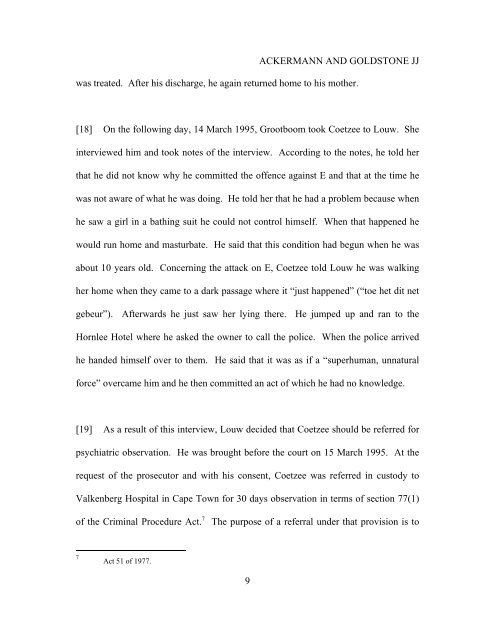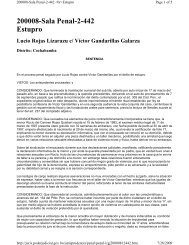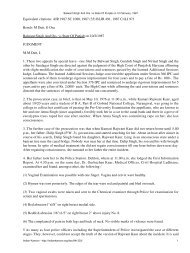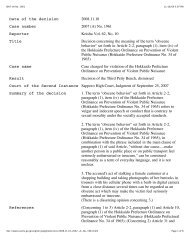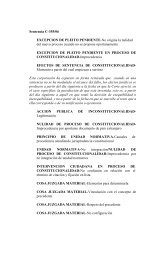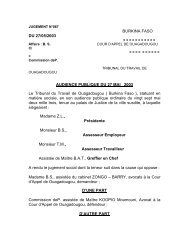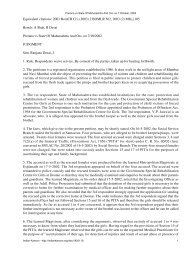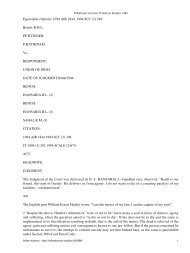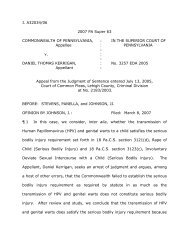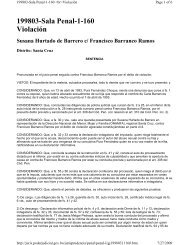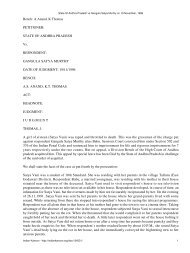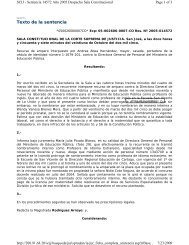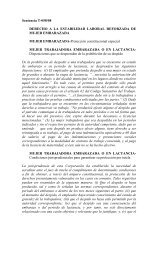CONSTITUTIONAL COURT OF SOUTH AFRICA Case CCT ... - saflii
CONSTITUTIONAL COURT OF SOUTH AFRICA Case CCT ... - saflii
CONSTITUTIONAL COURT OF SOUTH AFRICA Case CCT ... - saflii
Create successful ePaper yourself
Turn your PDF publications into a flip-book with our unique Google optimized e-Paper software.
ARTICLE IN PRESSR.C. Batra et al. / Engineering Analysis with Boundary Elements 30 (2006) 949–962 957Table 2For the circular MEMS, comparison of the MLPG results with those fromthe method of Section 5.2.1x 2Method of Section 5.2.1MLPGl PI ku PI k 1 l PI ku PI k 10.7890 0.4365 0.7915 0.44331λ = 0.485u(x 1 ,x 2 )0-0.20-0.4-0.6-0.800.25x 20.50.250.75x 10.50.75Fig. 8. Deformed shape of a quarter of the circular MEMS for l ¼ 0:485.domain. We compare our results with those obtained in[12] by the finite-difference method using 1600 points.In the MLPG implementation, we use the 165 nodeslocated as shown in Fig. 9. Values of weight functionsparameters are the same as those for the circular diskproblem studied in Section 5.2.Fig. 10 exhibits the infinity norm of the deflection versusthe load parameter l. Numerical solutions from the MLPGand the finite-difference methods are compared in Table 3.The symmetry breaking voltage, l SB , is less than the pull-involtage l PI , and the maximum difference between thecorresponding values of l PI , ku PI k 1 and l SB is 1:53%.Figs. 11a and b report the symmetric, and theasymmetric deformed shapes of the annular disk after thepull-in, for l ¼ 1:34, and 1:18, respectively.Fig. 12 depicts the variation of the pull-in parameters,l PI and ku PI k 1 , with the ratio (inner radius)/(outer radius),1keeping the outer radius at the constant value 1. TheMLPG results are computed using 165 nodes. Thenondimensional pull-in voltage data are fitted with aquadratic polynomial (dashed line), and the correspondingnondimensional pull-in maximum deflections with a polynomialof degree zero (solid line). Expressions for theaforementioned polynomials arel PI ¼ 1:33 þ 16:3 r 2 ; ku PI k 1 ¼ 0:390,where r is the ratio (inner radius)/(outer radius). Whereasthe maximum pull-in deflection is nearly independent of theratio of the inner to the outer radius of the MEMS, thepull-in voltage increases essentially quadratically with thisratio. Fig. 13 exhibits the dependence of symmetry breakingparameters, l SB and ku SB k 1 , upon the ratio of the innerto the outer radius of the annular disk. With increasinginner radii, the nondimensional pull-in voltage l PI significantlyincreases due to increased stiffness of the system,and the same holds for the nondimensional lowestsymmetry breaking voltage, l SB . Whereas the nondimensionalpull-in maximum deflection, ku PI k 1 , is virtuallyindependent of the inner radius of the disk, the nondimensionalsymmetry breaking maximum deflection, ku SB k 1 ,decreases with increasing inner radius. Expressions for thebest fit polynomials in Fig. 13 arel SB ¼ 1:27 þ 16:6r 2 ; ku SB k 1 ¼ 0:513 0:254r.Fig. 14 shows the variation with the ratio r, of thequantity ðr rÞ=ð1 rÞ, where r is the ratio between theradial location of the nondimensional pull-in maximumdisplacement ku PI k 1 , and the outer radius of the ring.MLPG data are fitted with a quadratic polynomial (solidline) whose expression isr1 r ¼ 0:343 þ 0:450r 0:423r2 .r 5.4. Elliptic disk0.1Fig. 9. Locations of 165 nodes on one-half of an annular disk.We consider an ellipse of semi-major axis a ¼ 1, semiminoraxis b, and clamped along its periphery. We analyze1x 1


